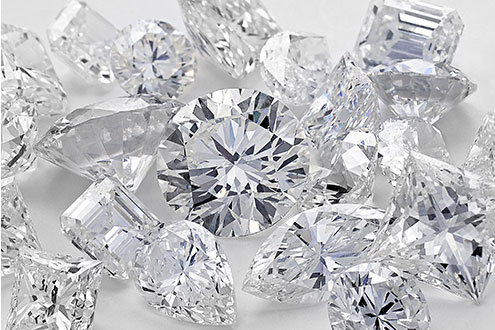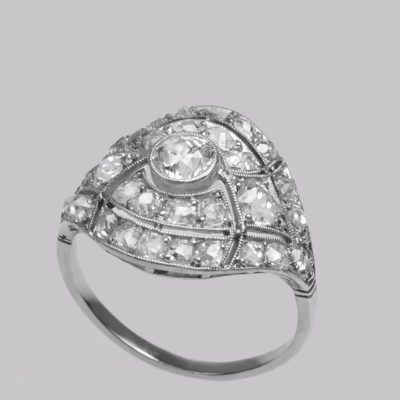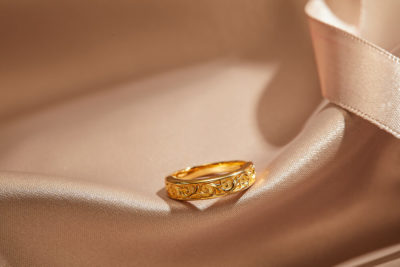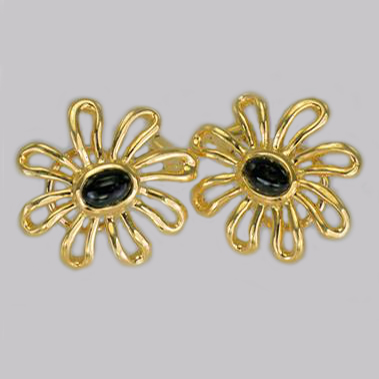
Diamonds have been around forever – literally! When you ask how old is this diamond remember most diamonds were created by nature at the birth of the Earth billions of years ago and other still older diamond came to earth via meteorites from distant stars. They were first found in India about 5000 years ago, they just like any stone and are known as rough diamonds. Largely diamonds only came from India until the 18th century. Here at The Chelsea Bijouterie, we like to think we can answer pretty much any question about the diamonds used in our vintage Jewellery.
So what is a Diamond?
Diamond is a mineral that is a crystalline form of carbon, element C. Graphite is also carbon, element C. However the atoms of these two minerals are joined in very different manners. Those of graphite are loosely formed whereas those of diamond is formed in a tight 3-dimensional pattern with a strong bond in all directions which is why diamond is the hardest natural substance known to man, 10 on the Mohs scale of hardness. This is just one of the properties that make diamonds an ideal gem for everyday wear.
Diamonds formed billions of years ago, hundreds of miles below the Earths surface under the effects very high temperatures and extreme pressures. Once formed they may remain there for millions or even billions of years until some kind of geological events brings them to the surface. Once out in fresh air, they may be washed along in rivers, and are then known as “alluvial deposits”. If they were to be carried as far as the sea then they are known as “marine deposits”.
In the middle of the 19th century, diamonds were found in South Africa at Orange River. By the beginning of the 20th century, South Africa was the worlds top diamond producing country. The sheer volume of diamond produced In South Africa meant the price dropped and diamonds became accessible tho the European and American middle classes. During the early 20th-century large diamond deposits were found in Australia, Russia and Canada. Traditionally, all sorting of rough diamonds took place in London, DTC Diamond Trading Company – De Beers. Today only Russian diamonds and Canadian diamonds are sorted in London.
When assessing the quality of diamonds we need to consider the (4Cs), colour, clarity, cut and carat.
The colour of a diamond is of the utmost importance, the ideal colour of a diamond is in fact “no colour” ie colourless just like clear glass. In-fact diamonds come in all colours, but mostly we are concerned with colourless diamonds – sometimes incorrectly referred to as white diamonds – but white is not the same thing as clear. A diamond’s colour is compared to a set of standard stones. D is colourless, H is near colourless, L is faint yellow, P is a very light yellow, U to Z is light yellow, Z+ is fancy yellow
Next, we can think about Clarity – how clear – how flawless. This is assessed first with the naked eye and then with an x10 loope – magnifying glass. Virtually all diamonds contain small traces of black carbon and non-diamond material, known as inclusions. The fewer there are the rarer and more expensive the stone. Inclusions are natures fingerprints and as no two diamonds contain the same inclusions, they render your diamond unique. To grade diamonds, we use a “grading Scale” There are several different ones. AGS – American Gemological Society. SCAN D.N. – Scandinavian nomenclature. CIBJO – The World Jewellery Confederation. HRD – Belgian Hoge Raad Voor Diamant (Antwerp Diamond High Council).
Clarity grades relating to internal defects
FL (flawless) – no inclusions or marks visible even to a skilled expert grader, with loope.
IF (internally flawless) – no inclusions visible even to a skilled expert grader, with loope.
VVS1 and VVS2 (very, very slightly included) – difficult for the grader to see with loope.
VS1 and VS2 (very slightly included) – inclusions clearly visible to grader with loope.
SI1 and SI2 (slightly included) – inclusions visible to a grader with a loope.
I1, I2 and I3 (inclusions are obvious and may impede clarity) – to grader with loope.
Cut
The cut of a diamond is its only characteristic engineered by man. The cut of a diamond relates to the proportions and finish of its facets. How a rough diamond is cut will affect all the other properties of the diamond, its brilliance, its fire and its scintillation. Since the invention of the round brilliant cut at around the turn of the 20th century, there is only two cuts, the round brilliant and then all others, some call these others fancy cuts. The surfaces which are cut flat are known as facets. The large centre facet is called the table and the pointed bit at the bottom is the culet. The circumference around a round cut diamond is known as the girdle.
The search for the perfect cut diamond.
Historically, rough diamonds were cut ie faceted to preserve as much of the rough stone as possible. This led to diamonds of odd and strange shapes. The shape of a diamond is determined by the way in which it is cut and worked and finally polished. The early shapes of cut stones were simple. The shapes were restricted by the tools and technology of the time. As techniques, knowledge and tools improved the cuts became more and more complex. Over time cutters came to realise that a round shape diamond with a large top facet and several side facets gave most sparkle and fire. Over the years all this work and research led to the idea that there must be an ideal cut, that would produce a perfect diamond. In 1919. Marcel Tolkowsky developed a cutting formula for a round diamond. He cut diamonds to his mathematical formula, to precise angles and proportions which would give the best reflection and refraction of light. the proportions he used produced a truly beautiful diamond, which became the “modern brilliant cut”, originally known as the “American ideal cut”
Traditionally the basic diamond shapes were – point cut, table cut, old single cut, mazarine cut, Peruzzi cut and old European cut.
Today diamonds are sometimes divided into two groups, round and then all other shapes are known as “fancy”.
Also, there are basically three fundamental styles of cut on which all others are modelled. Firstly the brilliant-cut with 57 or 58 facets. Then there is a step cut, usually four-sided and elongated. Finally mixed cut containing a mixture of brilliant and step-cut facets.
Brilliant Cut
Brilliant Cut diamonds come in several guises, firstly and most importantly, round brilliant, then the others – oval brilliant, pear brilliant, marquise or boat brilliant, and heart brilliant, all have 57 or 58 facets.
Emerald-Cut
Emerald cut diamonds are the most popular fancy cut. They are based on the old step cut but with the corners cut off. They have less fire than round brilliants but can give flashes of light and beauty which would be hard to find in other diamonds. Because emerald cut diamonds have such a large table facet, imperfections and or inclusions are very evident.
Royal Asscher Cut
In 1902 Joseph Asscher developed and patented the “Assher Cut”. His company went on in 1908 to be given the job of cutting the worlds largest diamond, the 3 105 carat Cullinan diamond. In 2001 Edward and Joop Asscher introduced and patented the ” Royal Asscher Cut”, 74 facets. Every Royal Asscher cut diamond is laser inscribed with the Royal Asscher logo and an identification number. They also all come with a certificate, on the GIA paperwork they are described as “modified square emerald cut”
Cushion Cut.
Cushion cut diamond have rounded corners and straight sections of the girdle. This shape around 100 years ago was known as “old mine cut” – not to be confused with “old European cut” which was of round section. This interesting shape has been popular for centuries. This pillow form is, of course, a fancy cut, and has many romantic connotations due to its somewhat natural shape and the way it behaves in candlelight.
Radiant Cut
The radiant cut is based on the emerald cut, but with 70 facets. This cut is often used with coloured fancy diamond, the facets intensify and accentuate the colours. The radiant was the first square cut to have both the crown and the pavilion with a full complement of brilliant facets.
Princess Cut
The princess cut is sometimes referred to as a square modified brilliant, due to its faceting being similar to a round brilliant. The side facets are brilliant in nature, ie triangular and kite-shaped. Princess can have from 49 to 78 facets, normally the latter. This is a relatively new cut which is increasing in popularity.
Marquise Cut
The traditional marquise cut is a combined 56 facet variation of a round brilliant and an oval cut. The marquise shape emphasises the carat weight of the diamond, making it appear much larger than it is. With its 56 facets and slender shape make this cut ideal for finger rings and earrings. The elongated shape flatters the finger or neck with its’s regal form and pointed ends. Legend has it that the name derives from the Marquise de Pompadour. It is said that Louis X1V, the Sun King of France, wanted a diamond polished into the shape of the marquise’s smile.
Pear Shape Cut
The pear shape cut can be seen as a cross between a round brilliant cut and the marquise cut. The pear shape cut is also known as a teardrop. The pear shape cut diamond is ideal for earrings and pendants as well as finger rings and this cut often used as accent diamonds. This cut also allows a range of cutting styles, fatter -thinner or longer according to taste.
If you would like to know more about the Jewellery that we sell, please get in touch.




